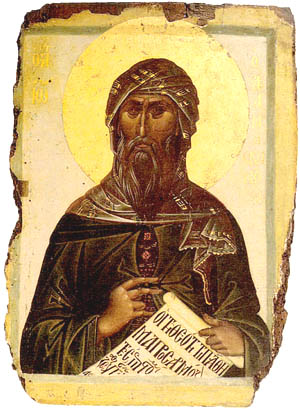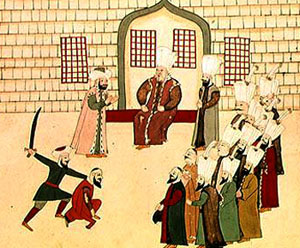 |
The Saint of the Day
St. John Damascene – March 27
Prof. Plinio Corrêa de Oliveira
Biographical selection:
St. John Damascene, 8th century, was the grand vizir of the Caliph of Damascus. While he was holding this office, Emperor Leo the Isaurian began a campaign to destroy the Catholic statues, the beginning of the iconoclast heresy. In 726 he issued his first edict against the veneration of images.

St. John Damascene
|
John Damascene immediately took up his pen to defend this ancient practice of Catholics, just as before he had attacked the heresies of his time. Because of this defense, the hand that wrote it was chopped off , but the Virgin Mary appeared and reattached the hand.
He retired to the monastery of St. Sabas southeast of Jerusalem and died there as a monk dedicated to prayer and study. He wrote numerous works and beautiful verses. His style was vigorous and polemic. For example, writing against the Emperor he called him a new Mahomet, an enemy of Christ, and despiser of the Saints. He also attacked the sycophant Bishops, calling them slaves of their stomachs, disposed to compromise and lie.
Writing about the holy statues, he said:
“Regarding the Most Holy Mother of God, I confess her holier than the Seraphim and Cherubim, more sublime than Heaven, more elevated than all creatures, for she brought to light of day Christ our God.
“As for the Saints who combated for Him, I honor and venerate them, kissing their precious relics. In the Bible the sacred writer gives an account of the Incarnation of Christ. The sculptor pictures the glory of the Church from the first Adam to the birth of Christ. The writer and artist concur on the same truth. The Church benefits from both, but you, O heretic, venerate the book and destroy the statue. What an extravagance!
“If some ignorant person commits some excess in this matter, it is your fault. If someone makes the mistake of taking the image of Christ for Christ Himself, you should instruct him. This is why you are Bishops, priests and deacons. The true Shepherds and Doctors, the shining lights of times past, dedicated themselves to instructing the people for their good and salvation. But the Bishops of this century are preoccupied with horses, cows, sheep, flocks, fields and gold. They care only about accruing and spending money. They are very concerned about the body, but neglect their people and their own souls. It is as Scriptures says: The shepherds became wolves.
“Who should we follow now, St. Basil the Thaumaturge, or Bastilas the murderer of souls? The doctor or penance and salvation St. John Chrysostom or the doctor of disorder and perdition Tricarcade? Or perhaps Gregory, the profane patriarch of Constantine, plague of the people, who along with the head of the Empire cast out the venerable statues and holy doctrine of the Holy Church?
"To whom should we listen? The ensemble of venerable Patriarchs who spoke at the first six Councils or these hypocrite prelates who introduced adulterous dogmas in the Church, which were never confirmed by any Patriarch and are proscribed by the Letters of Synods?”
Comments of Prof. Plinio:
Some prior observations will help us to better understand this selection. In the Muslim world, the Caliph was a mixture of pope and emperor. He was a religious leader who at the same time exercised temporal power. The grand vizir was the equivalent of a prime minister. He was the man appointed by the caliph to administer the government. Normally the caliphs would not deign to associate with the people, who were considered unworthy to even be in their presence. It was the grand vizirs who represented them; they were the face of the caliph for the public.

St. John Damascene fought the Iconoclast heresy
|
St. John Damascene, then, was the grand vizir of the Caliph of Damascus. At that time the caliphs permitted Catholics to practice their religion and hold important public offices in that Muslim state. There was, therefore, this paradox: a Saint who was protected by a Muslim Caliphate and who attacked a heretic who was head of the Catholic Byzantine Empire.
Emperor Leo the Isaurian was the one who initiated the campaign against the statues. It was the Iconoclast heresy, which means those who destroy icons and statues. Leo the Isaurian was a pre-figure of the Protestants. Among other errors, he sustained that it was wrong to venerate statues. On his orders, the heretics burned and destroyed countless statues in the Byzantine churches.
In this most beautiful text of St. John Damascene, you see the indignation of a soul of fire against error. The excerpt demonstrates that the indignation of St. John Damascene was filled with love for the truth. He vigorously proclaims the truths he defends.
In this text there are some very valuable arguments. For example, when he addresses the Iconoclasts, he points out the inconsistency of their position of destroying the statues but venerating the Bible. The Bible, he argues, describes personages in words, that is, it gives a literary representation of the person. The artist, taking his inspiration from that description, paints a picture or sculpts a statue. Therefore, if one takes a stand against the statues of persons, he should also be against the Bible that describes them. Otherwise his position is contradictory. He would accept the literary description but condemn the artistic figure representing the former. It is a simple but iron-tight argument presented with great literary beauty.
In another argument against the heretic bishops and clergy, he says: “If an ignorant person commits some excess in this matter, it is your fault. If someone makes the mistake of taking the image of Christ for Christ Himself, you should instruct him. This is why you are bishops, priests and deacons.”
You can see that the heretics of those times used the same sophism of Protestants who would later affirm that Catholics adore statues and Our Lady. When the heretic bishops and clergy asserted that the statues should be destroyed to avoid such excesses, St. John Damascene replied: “You are in charge of the instruction of the people. If there is some excess in the veneration of statues, it is because you did not fulfill your duty. Therefore, to be consistent, if you want to condemn someone, you should condemn yourselves, and instead of censuring and breaking the statues, you should correct yourselves.” Again, it is a simple, strong logic that leaves no exit for the adversary.
We should not be surprised that the heretic Emperor ordered the hand of St. John Damascene to be chopped off. The heretic could not face this iron logic of the Saint, so Leo the Isaurian took this violent measure to stop the Saint from attacking him. But Our Lady – who is the destroyer of all heresies - restored his hand so that he could continue to write against the enemies of the Church.

A grand vizir orders the execution of a guilty man
|
A final important consideration is that St. John Damascene - with this spirit of fire and Catholic mentality - was chosen by the Caliph to be his grand vizir. The Caliph was a Muslim and an enemy of the Catholic Church; notwithstanding, he had the good sense to admire the honesty and capacity of St. John Damascene and appointed him to govern his temporal possessions.
Now let me ask you this: Do you imagine it would be possible today for a man with the mentality of St. John Damascene to ever be made prime minister of Russia? Or even a head of one of our Western States? Could he be prime minister of England or president of the United States? He would certainly not be accepted. Why?
Because the revolutionary mentality of the people today is much worse than the mentality of the enemies of the Church was in the 8th century. This comparison makes us understand how low we have sunk and how bad the revolutionary mentality is. Normally we are blinded by this revolutionary mentality and we do not realize how perverse it really is.
This example shows how hostile the modern world is to the Catholic cause, and how bad the progressivists are who are trying to adapt the Church to this world.
Let us pray to St. John Damascene and ask him to give us the mentality he had in order to destroy the Revolution just as he destroyed the Iconoclast heresy in his time.


  | | Prof. Plinio Corrêa de Oliveira | |
The Saint of the Day features highlights from the lives of saints based on comments made by the late Prof. Plinio Corrêa de Oliveira. Following the example of St. John Bosco who used to make similar talks for the boys of his College, each evening it was Prof. Plinio’s custom to make a short commentary on the lives of the next day’s saint in a meeting for youth in order to encourage them in the practice of virtue and love for the Catholic Church. TIA thought that its readers could profit from these valuable commentaries.
The texts of both the biographical data and the comments come from personal notes taken by Atila S. Guimarães from 1964 to 1995. Given the fact that the source is a personal notebook, it is possible that at times the biographic notes transcribed here will not rigorously follow the original text read by Prof. Plinio. The commentaries have also been adapted and translated for TIA’s site.
|
Saint of the Day | Home | Books | CDs | Search | Contact Us | Donate

© 2002- Tradition in Action, Inc. All Rights Reserved
|
 |

|